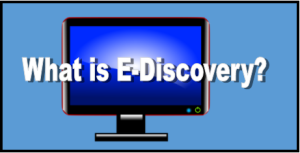What is E-Discovery? Part 4- Review
 This is the fourth post in a series of five providing a roadmap for you to develop your own e-discovery plan. The first post provided an introduction to e-discovery and the E-Discovery Reference Model, which provides the framework for this blog series. The second post addressed the stages of Identification, Preservation, and Collection. The third post addressed Processing standards. This post will address Review.
This is the fourth post in a series of five providing a roadmap for you to develop your own e-discovery plan. The first post provided an introduction to e-discovery and the E-Discovery Reference Model, which provides the framework for this blog series. The second post addressed the stages of Identification, Preservation, and Collection. The third post addressed Processing standards. This post will address Review.
When it comes to reviewing your documents, there are many options to choose from. You can purchase document review software that will help expedite your review. If that is simply not an option, you can also conduct your review with a Microsoft Excel spreadsheet and PDF files.
E-Discovery review software is offered by a number of vendors; Catalyst, Concordance, Eclipse, Kroll Ontrack, Relativity, and Summation are just some of the options. Review software comes in a desktop version, which can be purchased for a one-time fee and is downloaded onto your computer, or a web version, which is hosted on the internet. Web-based software is usually hosted and managed by a vendor and can be used on a case-by-case basis. The advantages to review software is that they streamline and expedite your review. The level of efficiency depends on the products and the bells and whistles they offer.
How does this software work? Basically, it captures the document’s metadata and image, allowing you to scroll through the images or search on the metadata. They also provide many tagging options, so you can code your documents and type in notes in one portion of the software while you look at the image in another. If you’ve never seen one before, imagine you have two screens. On one screen is an excel spread sheet. Each document has its own row, with columns containing the metadata. On your second screen is a picture (image) of the document. As you click through the rows on the spreadsheet, the image screen automatically advances.
E-Discovery platforms can also offer analytics (or TAR – technology assisted review) that will help you review your documents more efficiently. These tools can organize your data by concepts using key terms and custodians, or organize e-mail chains so that they can be reviewed together, or predict the relevance of documents in your data set (predictive coding). Predictive coding utilizes a seed set to develop an algorithm and push it across the data set. What does this mean? In very simplistic terms, an attorney reviews 1,000 documents. The software identifies trends in what was marked responsive. It then applies these trends to the rest of the 20,000 data set, and pulls back 7,000 additional documents that it thinks are most similar to the documents marked responsive.
If review software is simply not an option for you, you can use an actual excel spreadsheet and PDF files. It won’t be as convenient and you will lose a lot of the searching capabilities, but at least you’ll have something! A vendor can extract the metadata into an Excel file and assign an internal number to each document. Then they can create a PDF with the internal number as a title.
The next and last post will cover production of your reviewed documents.




